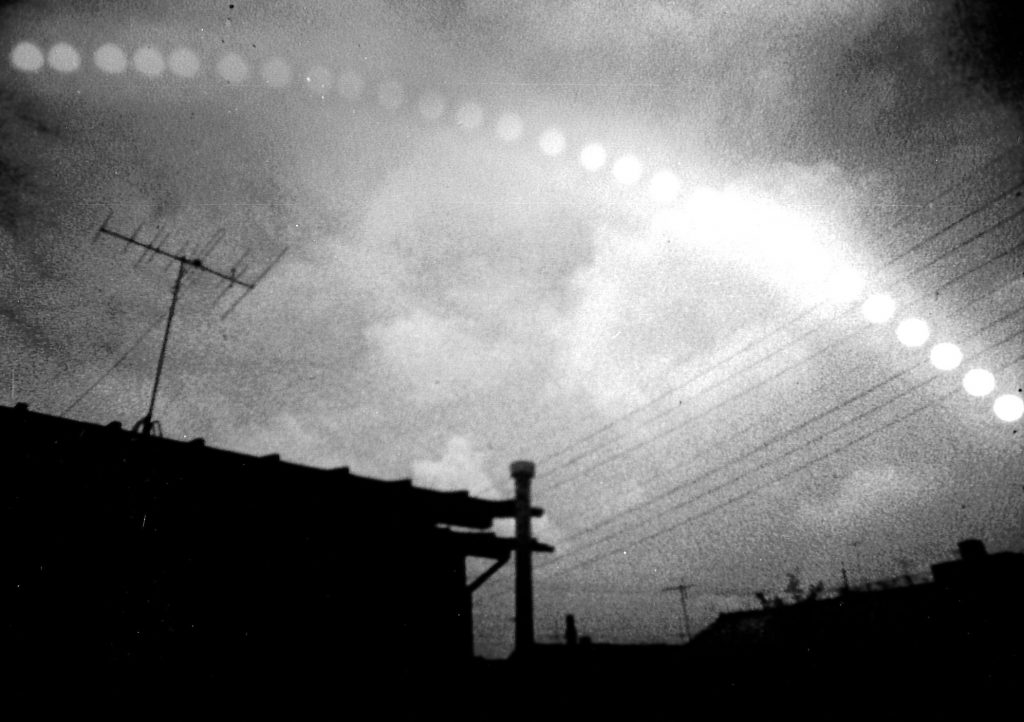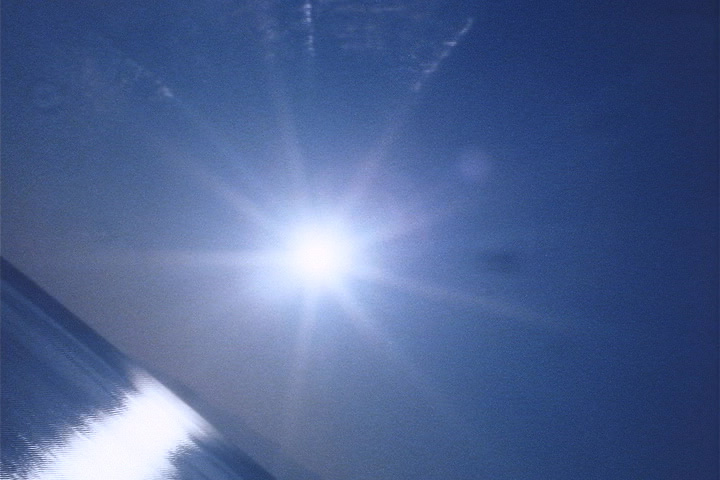P Tribute to YAMAZAKI Hiroshi
The Moving Images of YAMAZAKI Hiroshi
Nostalgia (U.S.), a film by photographer Hollis Frampton composed of thirteen photographs, was released in 1971. Four years later, photographer YAMAZAKI Hiroshi made Observation (1975), a film in which he created the illusion of twenty-eight suns in the sky over a residential neighborhood. These works reflect very different tastes, but both are unmistakably masterpieces. I say unmistakably because Frampton’s bold idea of having the photographs and the narration that explains them shifted by one shot and Yamazaki’s surprising exposure in which what appear to be multiple suns create an arc as they shift across the screen both possess a definitive form that would inevitably fade if someone else were to imitate them.
Another point in common between these two works is their sense of time. Perhaps these filmmakers chose the medium of cinema in order to share with viewers the unique and mysterious period of time during which images slowly appear over several minutes as photographic paper soaks in a fixing bath. The editing style is extremely restrained, with images appearing and disappearing at regular intervals, but the viewer is moved as though seeing something for the first time. Around this time an approach to moving images completely opposite to the standard montage technique was birthed through the sensibilities of photographers.
Speaking of opposite, this marked a major shift from the works focusing on snapshots Yamazaki had made throughout the 1960s. For a period of time he switched from a still camera to a Swiss-made Bolex 16mm movie camera capable of stop-motion photography, and out of this transition came the unusual practice of rolling a pair of dice when shooting and setting the f-stop based on the numbers that came up. This approach, which resulted in changing the f-stop from shot to shot based on random values (f1.8, f5.6, and so on), created a flickering that at first glance seems unrelated to production, an effect that evokes the era of Niépce in the early 19th century, a time of invention when photographs were taken over and over again in a process of trial and error.
He made several works between Fix (1972) and Observation, but YAMAZAKI had already prepared the process he would use next. Heliography (1979), which was made after the Vision series (1973〜1978), surprises with its unusual composition. With a diagonally positioned horizon, as time passes the surface of the ocean and nighttime scenery reflecting the sunlight that appears from the edge of the screen eventually cover its entirety. At first it seems like a scene viewed from an airplane window, but it this hypothesis is rejected when we notice that the sun remains fixed in the center of the screen. After the sun eventually sets, we are startled to notice our line of sight following its position and tracing its axis even after it is no longer visible; we have been watching a visualization of the heliocentric theory.
The source of Yamazaki’s inspiration can be traced backward from the 19th century all the way to the time of Galileo, but he was by no means squinting his eyes and casually musing on a journey to the past. Making the great randomness of optics his ally, I think he was putting all of his energies into plotting a “revision” of the world of optical science.

P-2Tribute to YAMAZAKI Hiroshi2
Nostalgia (U.S.), a film by photographer Hollis Frampton composed of thirteen photographs, was released in 1971. Four years later, photographer YAMAZAKI Hiroshi made Observation (1975), a film in which he created the illusion of twenty-eight suns in the sky over a residential neighborhood. These works reflect very different tastes, but both are unmistakably masterpieces. I say unmistakably because Frampton’s bold idea of having the photographs and the narration that explains them shifted by one shot and Yamazaki’s surprising exposure in which what appear to be multiple suns create an arc as they shift across the screen both possess a definitive form that would inevitably fade if someone else were to imitate them.
Another point in common between these two works is their sense of time. Perhaps these filmmakers chose the medium of cinema in order to share with viewers the unique and mysterious period of time during which images slowly appear over several minutes as photographic paper soaks in a fixing bath. The editing style is extremely restrained, with images appearing and disappearing at regular intervals, but the viewer is moved as though seeing something for the first time. Around this time an approach to moving images completely opposite to the standard montage technique was birthed through the sensibilities of photographers.
Speaking of opposite, this marked a major shift from the works focusing on snapshots Yamazaki had made throughout the 1960s. For a period of time he switched from a still camera to a Swiss-made Bolex 16mm movie camera capable of stop-motion photography, and out of this transition came the unusual practice of rolling a pair of dice when shooting and setting the f-stop based on the numbers that came up. This approach, which resulted in changing the f-stop from shot to shot based on random values (f1.8, f5.6, and so on), created a flickering that at first glance seems unrelated to production, an effect that evokes the era of Niépce in the early 19th century, a time of invention when photographs were taken over and over again in a process of trial and error.
He made several works between Fix (1972) and Observation, but YAMAZAKI had already prepared the process he would use next. Heliography (1979), which was made after the Vision series (1973〜1978), surprises with its unusual composition. With a diagonally positioned horizon, as time passes the surface of the ocean and nighttime scenery reflecting the sunlight that appears from the edge of the screen eventually cover its entirety. At first it seems like a scene viewed from an airplane window, but it this hypothesis is rejected when we notice that the sun remains fixed in the center of the screen. After the sun eventually sets, we are startled to notice our line of sight following its position and tracing its axis even after it is no longer visible; we have been watching a visualization of the heliocentric theory.
The source of Yamazaki’s inspiration can be traced backward from the 19th century all the way to the time of Galileo, but he was by no means squinting his eyes and casually musing on a journey to the past. Making the great randomness of optics his ally, I think he was putting all of his energies into plotting a “revision” of the world of optical science.
NAKAJIMA Takashi

P-1Tribute to YAMAZAKI Hiroshi1


